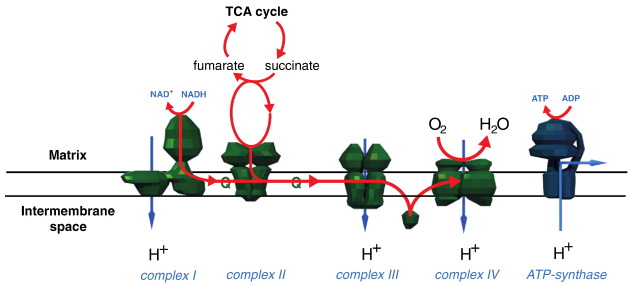Elsevier,
Mitochondrion, Volume 31, 1 November 2016
Mitochondrial respiratory chain dysfunction causes a variety of life-threatening diseases affecting about 1 in 4300 adults. These diseases are genetically heterogeneous, but have the same outcome; reduced activity of mitochondrial respiratory chain complexes causing decreased ATP production and potentially toxic accumulation of metabolites. Severity and tissue specificity of these effects varies between patients by unknown mechanisms and treatment options are limited. So far most research has focused on the complexes themselves, and the impact on overall cellular metabolism is largely unclear. To illustrate how computer modelling can be used to better understand the potential impact of these disorders and inspire new research directions and treatments, we simulated them using a computer model of human cardiomyocyte mitochondrial metabolism containing over 300 characterised reactions and transport steps with experimental parameters taken from the literature. Overall, simulations were consistent with patient symptoms, supporting their biological and medical significance. These simulations predicted: complex I deficiencies could be compensated using multiple pathways; complex II deficiencies had less metabolic flexibility due to impacting both the TCA cycle and the respiratory chain; and complex III and IV deficiencies caused greatest decreases in ATP production with metabolic consequences that parallel hypoxia. Our study demonstrates how results from computer models can be compared to a clinical phenotype and used as a tool for hypothesis generation for subsequent experimental testing. These simulations can enhance understanding of dysfunctional mitochondrial metabolism and suggest new avenues for research into treatment of mitochondrial disease and other areas of mitochondrial dysfunction.
Elsevier,
Press release November 1, 2016
Network organization Amsterdam Data Science (ADS) and Elsevier are collaborating together on several fronts, including research and development, joint promotion of Amsterdam as a data science center, and data science talent development. This partnership marks the first long-term collaboration agreement signed by ADS and is interetsed in advancing SDG 9 targets 5, B and C. A number of projects have already started. These are focused on improving data search and reproducibility of research that will ultimately result in higher quality research outcomes.
Elsevier, The Lancet, Volume 388, 8 October 2016
Background Improving survival and extending the longevity of life for all populations requires timely, robust evidence on local mortality levels and trends. The Global Burden of Disease 2015 Study (GBD 2015) provides a comprehensive assessment of all-cause and cause-specific mortality for 249 causes in 195 countries and territories from 1980 to 2015. These results informed an in-depth investigation of observed and expected mortality patterns based on sociodemographic measures.
Elsevier, The Lancet, Volume 388, 8 October 2016
Background Non-fatal outcomes of disease and injury increasingly detract from the ability of the world's population to live in full health, a trend largely attributable to an epidemiological transition in many countries from causes affecting children, to non-communicable diseases (NCDs) more common in adults. For the Global Burden of Diseases, Injuries, and Risk Factors Study 2015 (GBD 2015), we estimated the incidence, prevalence, and years lived with disability for diseases and injuries at the global, regional, and national scale over the period of 1990 to 2015.
Elsevier, The Lancet, Volume 388, 8 October 2016
Background Established in 2000, Millennium Development Goal 4 (MDG4) catalysed extraordinary political, financial, and social commitments to reduce under-5 mortality by two-thirds between 1990 and 2015. At the country level, the pace of progress in improving child survival has varied markedly, highlighting a crucial need to further examine potential drivers of accelerated or slowed decreases in child mortality.
Elsevier, The Lancet, Volume 388, 8 October 2016
Background In September, 2015, the UN General Assembly established the Sustainable Development Goals (SDGs). The SDGs specify 17 universal goals, 169 targets, and 230 indicators leading up to 2030. We provide an analysis of 33 health-related SDG indicators based on the Global Burden of Diseases, Injuries, and Risk Factors Study 2015 (GBD 2015). Methods We applied statistical methods to systematically compiled data to estimate the performance of 33 health-related SDG indicators for 188 countries from 1990 to 2015.
Elsevier, The Lancet, Volume 388, 8 October 2016
Background In transitioning from the Millennium Development Goal to the Sustainable Development Goal era, it is imperative to comprehensively assess progress toward reducing maternal mortality to identify areas of success, remaining challenges, and frame policy discussions. We aimed to quantify maternal mortality throughout the world by underlying cause and age from 1990 to 2015.

